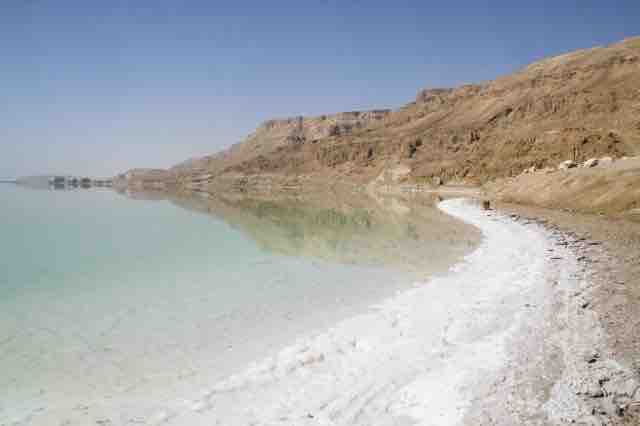Halophiles are extremophiles that thrive in environments with very high concentrations of salt. In fact, the very name "halophile" comes from the Greek word for "salt-loving. " Although some halophilic bacteria and eukaryotes exist, the largest classification of halophiles is in the Archaea domain.
Halophiles can be found anywhere with a salt concentration at least five times greater than that of the ocean. They are categorized as slight, moderate, or extreme halophiles based on the extent of their halotolerance. Halophiles thrive in places such as the Great Salt Lake , Owens Lake in California, evaporation ponds, and the Dead Sea - places that provide an inhospitable environment to most lifeforms.

Dead Sea
Salt builds up along the Dead Sea. These extreme conditions provides an inhospitable environment to most life forms.

Great Salt Lake
Halophiles are adapted to conditions of extreme salt concentration, such as the Great Salt Lake in Utah.
High salinity represents an extreme environment that relatively few organisms have been able to adapt to and occupy. Most halophilic organisms cope with the high concentrations of salt by expending energy to exclude salt from their cytoplasm to avoid protein aggregation, or "salting out. " "Normal" organisms would desiccate in these conditions, losing water via osmosis out of the cytoplasm. Halophiles prevent this loss of water by increasing the internal osmolarity of the cell. One way halophilic archaea can increase their internal osmolarity is by accumulating organic compounds - called osmoprotectants - in their cytoplasm. These compatible solutes can be accumulated from the environment or synthesized. The most common compatible solutes are neutral or zwitterionic, and include amino acids, sugars, polyols, betaines and ectoines, as well as derivatives of some of these compounds.
A more radical adaptation to preventing water loss employs the selective influx of potassium (K+) ions into the cytoplasm. In archaea, this adaptation is restricted to the the extremely halophilic family Haloarchaea (often known as Halobacteriaceae). To use this method, the entire intracellular machinery - including enzymes, structural proteins, and charged amino acids that allow the retention of water molecules on their surfaces - must be adapted to high salt levels. In the compatible solute adaptation, little or no adjustment is required of intracellular macromolecules – in fact, the compatible solutes often act as general stress protectants as well as osmoprotectants.
The extremely halophilic Haloarchaea require at least a 2 M salt concentration and are usually found in saturated solutions (about 36% w/v salts). These are the primary inhabitants of salt lakes, inland seas, and evaporating ponds of seawater. The red color of deep salterns is due to the carotenoids (organic pigment) in these archaea. These archaea require salt for growth and they will lyse if they are exposed to less salty environment.
The high concentration of NaCl in halophilic environment limits the availability of oxygen for respiration. Halophiles are chemoheterotrophs, using light for energy and methane as a carbon source under aerobic or anaerobic conditions.